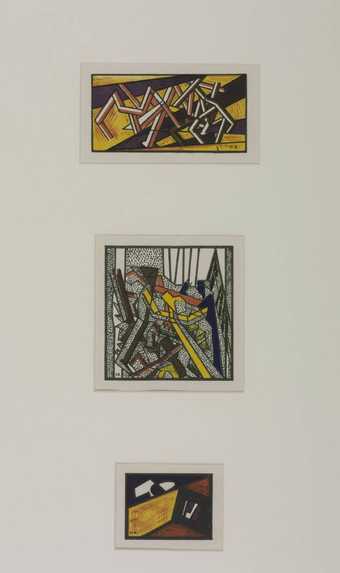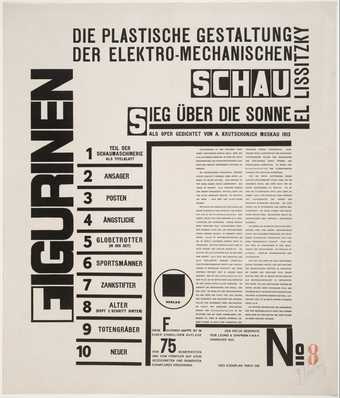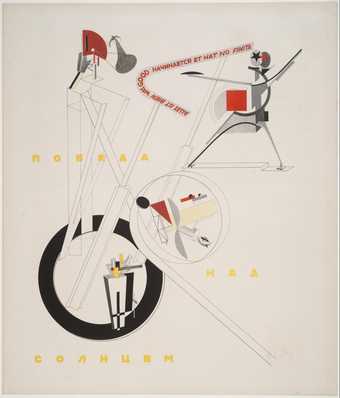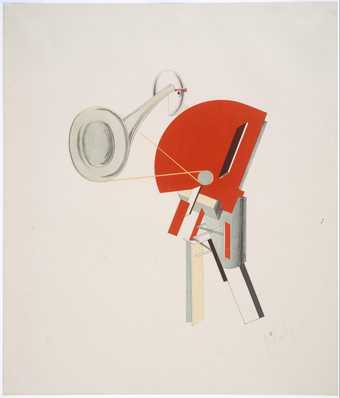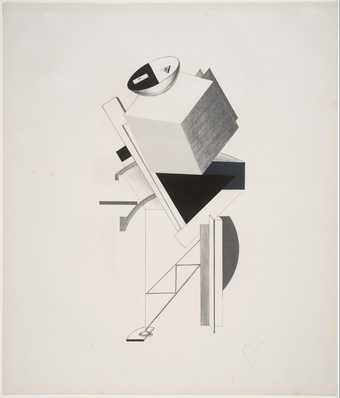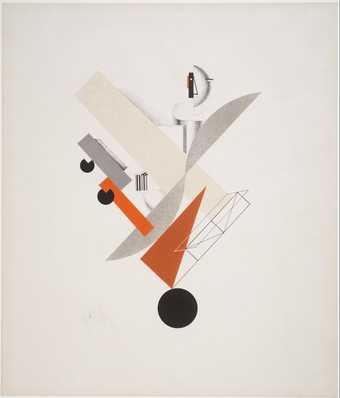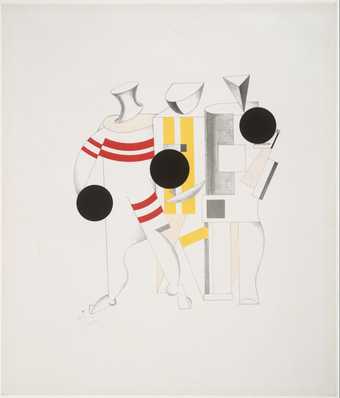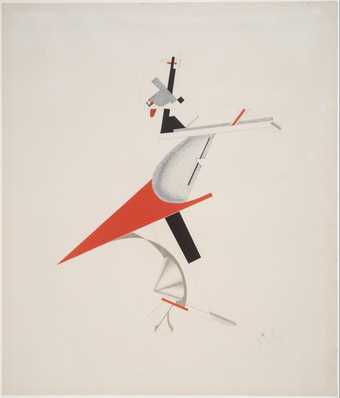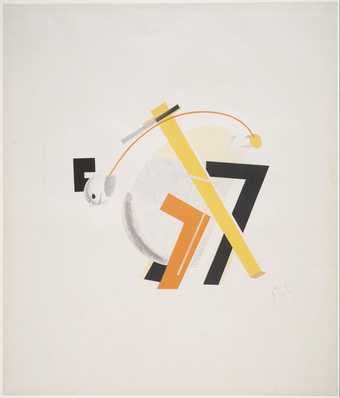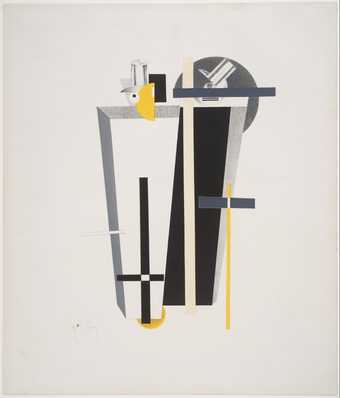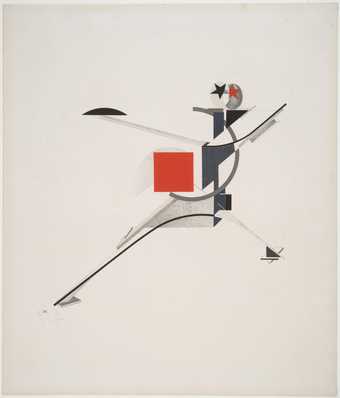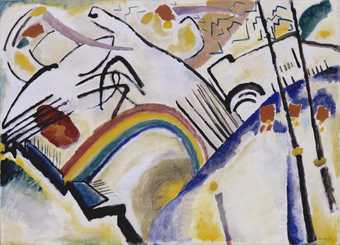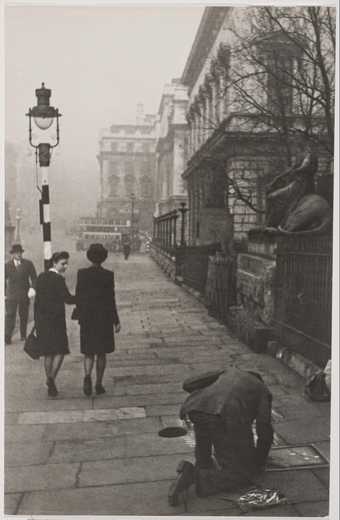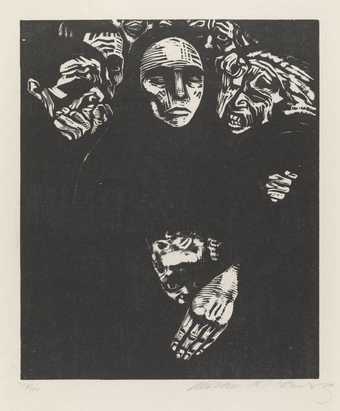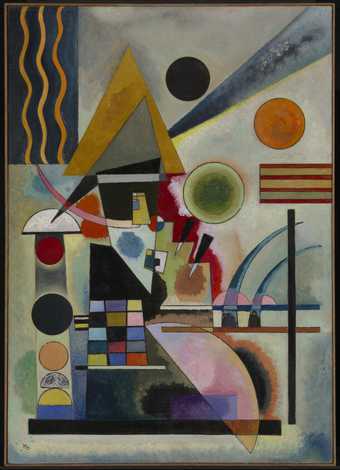
In Tate Liverpool
- Artist
- El Lissitzky 1890–1941
- Part of
- Victory Over the Sun
- Original title
- Ängstliche
- Medium
- Lithograph on paper
- Dimensions
- Image: 512 × 430 mm
support: 535 × 455 mm
mount: 840 × 590 × 7mm (A1) - Collection
- Tate
- Acquisition
- Purchased 1976
- Reference
- P07141
Catalogue entry
This catalogue entry discusses a group of works.
El Lissitzky
1890-1941
P07137-47 Victory over the Sun
1923
Each sheet is inscribed 'El Lissitzky' either b.l. or b.r.; the title page is also numbered '8' b.r.
Portfolio of lithographs comprising a cardboard case, a title page in black (P07137) and ten colour lithographs on paper approx. 20 1/8 x 16 7/8 (51 x 43)
Purchased from Mrs Donald Ogden Stewart (Grant-in-Aid) 1976
Prov:
Mrs Sophie Lissitzky-Küppers, Moscow; Mrs Donald Ogden Stewart (Ella Winter), New York and London, 1944
Exh:
Russian Graphic Art - XVIII to XX Centuries, Hatton Gallery, University of Newcastle upon Tyne, November-December 1978 (231-40)
Lit:
Horst Richter, El Lissitzky: Sieg über die Sonne: zur Kunst des Konstruktivismus
(Cologne 1958), the title page and all 10 colour lithographs repr.; exh. catalogue El Lissitzky, Stedelijk van Abbemuseum, Eindhoven, December 1965-January 1966 (and subsequently at Basle and Hanover), pp.65, 67-9, 72-3, print 10 repr.; Ella Winter, 'I bought a Klee' in Studio International, CLXXII, 1966, pp.24-6; Sophie Lissitzky-Küppers, El Lissitzky
(London 1968), pp.34-6, 347-8, pls.52-63 (the cover, title-page and prints 1, 8, 5, 6, 9, 10 repr. in colour pls.52, 53, 55, 58-62 respectively); K.G. Pontus Hultén, The Machine as seen at the End of the Mechanical Age
(New York 1968), pp.128-131, print 1 repr. p.128, prints 2-5 repr. p.129, prints 6-9 p.130 and print 10 p.131; Philip Larson, 'El Lissitzky's "Victory over the Sun"' in Print Collector's Newsletter, VII, March-April 1976, pp. 10-11, print 10 repr. p.11
After a very successful one-man exhibition of Lissitzky's works at the Kestner-Gesellschaft in Hanover at the beginning of 1923, Lissitzky was commissioned to make a portfolio of colour lithographs as a New Year gift for the members of the Society. As this proved to be greatly in demand, the owner of the lithographic printing-press, Chapman, invited him to make a further portfolio. This time he decided not to make abstract works (Proun), but a series on the theme of puppets from a mechanical theatre for which he already had several watercolours which he had brought from Russia. Permission was given for him to use a room in the Kestner-Gesellschaft as a studio and he began the work of transferring his drawings on to the stone in the summer of 1923. The portfolio was published later the same year by the printers Rob. Leunis and Chapman of Hanover in an edition of 75 copies, of which the Tate's is no.8.
The first performance of Victory over the Sun in St. Petersburg in 1913 constituted a very important event in the history of the Russian avant-garde and was the joint creation of the playwright Alexei Kruchenykh, the designer Kasimir Malevich and the composer Mikhail Matyushin (see The Drama Review, XV, autumn 1971, published by the School of the Arts, New York University, for a translation and background information). Devised as a manifestation of Futurist theatre, it involved the deliberate disruption of rules of grammar and syntax, the invention of new words, and passages written in 'zaum', the Futurist transrational language of pure sound. Malevich's costumes were Cubist-like, made of painted cardboard and wire; one of his backdrops apparently consisted simply of a black and white square within a square divided diagonally.
Lissitzky would not have seen the original performances as they took place when he was living outside Russia, but the 'opera' was revived in Vitebsk in 1920 by the Unovis group of which he was a member, with d,cor by Yermolayeva; his first designs for a mechanical theatre version seem to have been done soon afterwards.
The portfolio has a case in red, with a design in black which when closed forms the letter F (for 'Figuren'). Then there is a title page in German headed 'The plastic form of the electro-mechanical peepshow Victory over the Sun from the opera written by A. Krutschonjch Moscow 1913'. The portfolio is stated to have been published in a single edition of 75 numbered copies drawn on the stone by the artist and signed by him, the printing being arranged by Rob. Leunis & Chapman G.M.B.H., in Hanover in 1923. Besides the word 'Figures' and a list of the subjects of the individual sheets numbered from 1 to 10, there is the following explanatory foreword by Lissitzky himself:
'In front of you is the fragment of a work which originated in Moscow in 1920-1. Here, as in all my works, my aim is not to reform something which already exists, but to bring something else into existence.
'Nobody pays any attention to the magnificent spectacle in our streets, for every "somebody" is in the play himself. Every energy is employed for a specific purpose. The whole is amorphous. All energies must be organized into a unity, crystallised, and put on show. In this way a work is produced - it may be called a work of art.
'We are constructing a stage on a square, which is open and accessible on all sides; that is the machinery of the show. This stage offers the "bodies in play" all the possibilities of movement. Therefore its individual parts must be capable of being shifted, revolved, extended, and so on. It must be possible to change over from one elevation to another quickly. Everything is rib-construction, so that the bodies circulating in the play will not be masked. The bodies themselves are each designed as occasion and volition demands. They glide, roll, float, on, in, and over the stage. All the parts of the stage and all the bodies are set in motion by means of electromechanical forces and devices, and the control centre is in the hands of a single individual. This is the creator of the show. His place is in the centre of the stage, at the switchboard controlling all the energies. He directs the movements, the sound and the light. He switches on the radio-megaphone, and across the square resounds the deafening noise of railway stations, the rushing of the Niagara Falls, the hammering of a rolling-mill. The creator speaks for the bodies, into a telephone which is connected with an arc-lamp, or into other devices which alter his voice according to the character of the individual figures. Sentences flash on and off electrically. Beams of light, refracted through prisms and mirrors, follow the movement of the bodies. Thus the creator raises the most elementary process to the highest degree of effectiveness.
'For the first presentation of this electromechanical peepshow I have used a modern play, which was still, however, written for the stage. It is the futurist opera "Victory over the Sun" by A. Kruchenykh who originated sound-poetry and is the leading writer of the most modern Russian poetic works. The opera was presented for the first time in 1913, in Petersburg. The music is by Matyushin (Quarter tones). Malevich painted the scenery (the curtain = black square).
'The sun as the expression of the world's age-old energy is torn down from the sky by modern man; the power of his technical supremacy creates for itself a new source of energy. This idea is woven into the opera simultaneously with the action. The language is alogical. Individual singing parts are phonetic poems.
'The text of the opera compelled me to preserve something of the anatomy of the human body in my puppets. The colours of the individual sections of these pages are to be regarded in the same way as in my Proun works, as equivalents to materials; that is to say, when the designs are put into effect, the red, yellow or black parts of the puppets are not painted correspondingly, but instead are made in corresponding material, for example in bright copper, dull iron, and so on.
'The further adaptation and application of the ideas and forms set down here I leave to others while I proceed to my next task.'
The individual prints are as follows:
1. Part of the Show Machinery
(P07138)
This incorporates the Elocutionist (top left), the New Man (top right), the Globetrotter (in Time) (centre) and the Gravediggers (bottom left), and contains some indication of the open rib-construction of the stage on different levels. The yellow writing in Russian 'POBEDA NAD SOLNTSEM' means 'Victory over the Sun'; the scroll-like text in several different languages 'ALLES IST BIEN WAS GOOD NACHINAESTA ET HAT NO FINITA' can be roughly translated 'All is well was good begins and has no end', and seems to have been inspired by the opening lines of the play:
The First One: All is well that begins well!
The Second One: What about the end?
The First One: There will be no end!
A preliminary drawing in pencil for this lithograph is reproduced in the book by Lissitzky-Küppers, pl.56, and one in pencil and gouache in the 1965-6 Eindhoven catalogue (A38b); neither is dated.
2. The Elocutionist (or Announcer)
(P07139)
A drawing for this in pencil was included in the Eindhoven exhibition (A38f) with the date 1923.
3. Postman
(P07140)
A pencil drawing for this was included in the Eindhoven exhibition (A38g) with the date 1923.
4. Anxious People (or the Cowards)
(P07141)
There was also a pencil drawing for this in the Eindhoven exhibition (A38i) with the date 1923.
5. Globetrotter (in Time)
(P07142)
The stage directions state that this character (also known as A Traveller through the Centuries) arrives in the wheels of an aeroplane and is covered with pieces of paper on which are written: Stone Age, Middle Ages, etc. The print includes some indication of an aeroplane, but has no inscriptions.
A preliminary pencil drawing was A38j in the Eindhoven exhibition, with the date 1923.
6. Sportsmen
(P07143)
A pencil drawing for this is reproduced in the Eindhoven catalogue (A38k) with the date 1923.
7. The Quarrelsome One (or Squabbler)
(P07144)
There were two pencil drawings for this in the Eindhoven exhibition (A38m and n), both with the date 1923.
8. Old Man (Head 2 Strides behind)
(P07145)
This character says:
My head is two steps behind my body - necessarily!
It continually lags behind!
Ah annoyance!
A preliminary pencil drawing reproduced by Lissitzky-Küppers pl.57 without a date is probably the one exhibited at Eindhoven (A38o) with the date 1923.
9. Gravediggers
(P07146)
According to the stage directions, the upper half of these characters is white and red, and the lower half is black, but Lissitzky has disregarded this.
A preliminary drawing in pencil and watercolour, said to have been made in Russia in 1920-1, belongs to Frau I. Vordemberge-Leda in Rapperswil. The Eindhoven exhibition also included a pencil drawing (A38p) made in 1923.
10. New Man
(P07147)
There was a drawing for this in pencil and gouache in the Eindhoven exhibition (A38q) with the date 1923.
The opera also includes several other characters who do not figure in this series.
Sophie Lissitzky-Küppers reproduces (pl.54) a design for the cover of a Russian edition, with the date c.1920, which seems to show that it was Lissitzky's intention from the beginning to issue his designs as a portfolio of lithographs.
Published in:
Ronald Alley, Catalogue of the Tate Gallery's Collection of Modern Art other than Works by British Artists, Tate Gallery and Sotheby Parke-Bernet, London 1981, pp.452-5, reproduced p.452
Explore
- abstraction(8,615)
-
- from recognisable sources(3,634)
- non-representational(6,161)
-
- geometric(3,072)
- emotions and human qualities(5,345)
-
- anxiety(1,028)
- music and entertainment(2,331)
- tools and machinery(1,287)
-
- robot(39)
- social comment(6,584)
-
- machine age(49)
You might like
-
David Bomberg iii
c.1914–19 -
El Lissitzky [title page]
1923 -
El Lissitzky 1. Part of the Show Machinery
1923 -
El Lissitzky 2. The Announcer
1923 -
El Lissitzky 3. Sentry
1923 -
El Lissitzky 5. Globetrotter (in Time)
1923 -
El Lissitzky 6. Sportsmen
1923 -
El Lissitzky 7. Troublemaker
1923 -
El Lissitzky 8. Old Man (Head 2 Steps behind)
1923 -
El Lissitzky 9. Gravediggers
1923 -
El Lissitzky 10. New Man
1923 -
Wassily Kandinsky Cossacks
1910–1 -
Ivan Shagin The poor artist, London
c.1945–55 -
Käthe Kollwitz The People
1922 -
Wassily Kandinsky Swinging
1925

